The Hairy giraffe… IN RAJASTHAN
After ten days in the United Arab Emirates, we continue our around-the-world journey with a 3-week trip to Rajasthan (including Delhi and Agra). The cultural, aesthetic, and sanitary shock is immense. Where the United Arab Emirates are sanitized and modern, India plunges us into a radically different world. The cities are incredibly noisy, overcrowded, and dirty.
The majority of Western tourists seem to travel in organized tours or, at the very least, with a guide and private driver. We opted (naively? courageously?) for a completely independent circuit. The advantage: we got to see India as it is, not just the calm and clean tourist sites. The downside: the stay was inevitably much more intense and tiring than if we had been guided.
How long? We spent 19 days in Rajasthan, including Delhi and Agra. If you only have 15 days, it’s entirely possible to follow the same itinerary as ours. As we went to India as part of our 8-month world tour, we had planned a few days or half-days of rest, which can be omitted if you want to shorten the duration of the trip.
When? In January. We wanted to avoid the monsoon but also the high temperatures that affect the region very early in the year. In January, we felt rather cold. Temperatures were supposedly around 20°C, but due to the pollution and fog that cover the region every winter, it could get very cold. It’s essential to note that the risk of seeing the Taj Mahal under thick fog in winter is high. We had planned to spend several nights in Agra, which allowed us to admire the site in the sun, but for the rest of our stay, the Taj Mahal was entirely covered. Nevertheless, considering the hygiene of the country (whether in the streets or trains), we are glad not to have traveled in intense heat or during the monsoon, which would have made the journey even more uncomfortable.
Ease of independent travel: 3 giraffes ![]() It is entirely possible to travel independently in Rajasthan. Trains connect the main cities, but delays are common. Hotels are always there to help you make reservations online. In cities, tuk-tuks are ubiquitous and will not hesitate to approach you (or even harass you). The fares are not very expensive, but bargaining is necessary. The Delhi and Jaipur metro is clean, efficient, safe, and very cheap. Uber is available in some cities for booking cars and tuk-tuks.
It is entirely possible to travel independently in Rajasthan. Trains connect the main cities, but delays are common. Hotels are always there to help you make reservations online. In cities, tuk-tuks are ubiquitous and will not hesitate to approach you (or even harass you). The fares are not very expensive, but bargaining is necessary. The Delhi and Jaipur metro is clean, efficient, safe, and very cheap. Uber is available in some cities for booking cars and tuk-tuks.
Costs: 2 giraffes ![]() India is not an expensive country, far from it! Transportation and food are very affordable. Accommodations are also cheap, but beware, do not expect Western comfort. Some entrance fees are quite high for foreigners, especially if you plan to visit multiple sites in each city: it can quickly add up!
India is not an expensive country, far from it! Transportation and food are very affordable. Accommodations are also cheap, but beware, do not expect Western comfort. Some entrance fees are quite high for foreigners, especially if you plan to visit multiple sites in each city: it can quickly add up!
Ease of communication : 3 giraffes ![]() English is spoken by many Indians, but be aware that not everyone speaks it, and you often encounter people who don’t speak it at all, even in the tourism industry. It can be challenging to communicate with tuk-tuk drivers who do not always read the Latin alphabet and prefer to see a photo of the hotel facade to confirm the destination. For non-English speakers, a little adaptation time may be necessary to familiarize yourself with Indian English.
English is spoken by many Indians, but be aware that not everyone speaks it, and you often encounter people who don’t speak it at all, even in the tourism industry. It can be challenging to communicate with tuk-tuk drivers who do not always read the Latin alphabet and prefer to see a photo of the hotel facade to confirm the destination. For non-English speakers, a little adaptation time may be necessary to familiarize yourself with Indian English.
Safety: 3 giraffes ![]() Overall, Rajasthan is safe. You have very little risk of being attacked or robbed. However, as soon as you walk on the street, there is a significant risk of being hit by a scooter, tuk-tuk, or car: traffic is dense and anarchic, you have to look everywhere all the time, and sidewalks are often nonexistent (so you have no choice but to walk along the road, a few centimeters from vehicles). Crossing a road can be a real challenge, as traffic rules are not followed by anyone.
Overall, Rajasthan is safe. You have very little risk of being attacked or robbed. However, as soon as you walk on the street, there is a significant risk of being hit by a scooter, tuk-tuk, or car: traffic is dense and anarchic, you have to look everywhere all the time, and sidewalks are often nonexistent (so you have no choice but to walk along the road, a few centimeters from vehicles). Crossing a road can be a real challenge, as traffic rules are not followed by anyone.
Health: 0 giraffe ![]() India is known for having deplorable food hygiene and a quick walk through the streets of any city confirms that this reputation is well-founded and extends to general hygiene. It’s challenging to find a mid-range hotel that is as clean as in the majority of the world. The water is not drinkable. You should be careful about what you eat and where you eat. The plague is endemic, and many diseases (rabies, HIV, hepatitis, etc.) are widespread. It’s better to travel with health insurance, a solution to disinfect water (UV lamp, filtering straw, etc.), up-to-date vaccinations… No need to be paranoid, but it’s better to avoid touching the numerous monkeys, goats, cows, and stray dogs that populate the streets and to be shaved by a street barber (who probably hasn’t disinfected his razor).
India is known for having deplorable food hygiene and a quick walk through the streets of any city confirms that this reputation is well-founded and extends to general hygiene. It’s challenging to find a mid-range hotel that is as clean as in the majority of the world. The water is not drinkable. You should be careful about what you eat and where you eat. The plague is endemic, and many diseases (rabies, HIV, hepatitis, etc.) are widespread. It’s better to travel with health insurance, a solution to disinfect water (UV lamp, filtering straw, etc.), up-to-date vaccinations… No need to be paranoid, but it’s better to avoid touching the numerous monkeys, goats, cows, and stray dogs that populate the streets and to be shaved by a street barber (who probably hasn’t disinfected his razor).
Gay friendly: 3 giraffes ![]() LGBT+ rights are evolving in India, and LGBT+ travelers should not face particular discriminations. It should be noted, however, that public displays of affection are rare for all couples. It is better to remain discreet. Still, we did not receive any pointed looks when booking rooms with a double bed.
LGBT+ rights are evolving in India, and LGBT+ travelers should not face particular discriminations. It should be noted, however, that public displays of affection are rare for all couples. It is better to remain discreet. Still, we did not receive any pointed looks when booking rooms with a double bed.
Travel ease: 2 giraffes ![]() Yes, it is possible to travel independently in Rajasthan. But be prepared for a tiring journey, with many hours on trains, walking or moving (in tuk-tuks) through dirty and extremely noisy streets. Pollution is high, exceeding WHO standards by 30 or 40 times. Although many bloggers praise the hospitality of the Indians, it is not the land of smiles. Many Indians approach you on the street and give you advice, but it’s almost always to sell you something later, even following and harassing you. If we add hygiene issues and the widespread lack of insulation in mid-range hotels, it is clear that Rajasthan is not an easy or relaxing trip.
Yes, it is possible to travel independently in Rajasthan. But be prepared for a tiring journey, with many hours on trains, walking or moving (in tuk-tuks) through dirty and extremely noisy streets. Pollution is high, exceeding WHO standards by 30 or 40 times. Although many bloggers praise the hospitality of the Indians, it is not the land of smiles. Many Indians approach you on the street and give you advice, but it’s almost always to sell you something later, even following and harassing you. If we add hygiene issues and the widespread lack of insulation in mid-range hotels, it is clear that Rajasthan is not an easy or relaxing trip.
Highlights: ![]() The Taj Mahal, Udaipur.
The Taj Mahal, Udaipur.
Letdowns: ![]() The cities, which are never small, relaxing, and clean.
The cities, which are never small, relaxing, and clean.
Check out our Travel Reflections articles on Rajasthan:
3-WEEK ITINERARY IN RAJASTHAN
Here is the detailed itinerary of our three weeks in Rajasthan:
Day 0: Flight to Delhi. Since India is the second country in our world tour, the flight is only 3 hours from Abu Dhabi. Delhi airport and the express metro to the city are quite modern. The cultural shock hits only upon exiting the metro at New Delhi station. Between the station and our hotel in Paharganj, we are immediately immersed in the city’s atmosphere.
Day 1: After a good night’s sleep (getting used to the constant noise of India, even at night), we start the day with a visit to Qutub Minar, the third tallest minaret in the world (dating back to the 12th century).





We then make our way to the Birla Mandir Hindu temple, inaugurated by Gandhi. While we usually enjoy walking in the cities we visit, we quickly understand that Indian cities are not the most pedestrian-friendly: not only is there a risk of accidents at every step, but also constant honking from tuk-tuks offering their services. It’s impossible to stroll peacefully amid such noise and amidst so much litter. However, we persist!





Day 2: We leave the hotel at 6:30 am to catch a train to Agra. The city is shrouded in thick fog, and the train takes 4 hours (instead of 2) to reach its destination. Similar to the streets, the tracks are covered in litter along the 150km journey.



The sky is almost as hazy in Agra, and we start to wonder if we’ll be able to see the Taj Mahal… We had anticipated this risk and had booked 3 nights to maximize our chances. Unfortunately, the reserved hotel is disappointing, and the room is freezing: it drops to 5°C at night with no heating available. Consequently, we decide to stay only 2 nights and head to Jaipur earlier than planned.
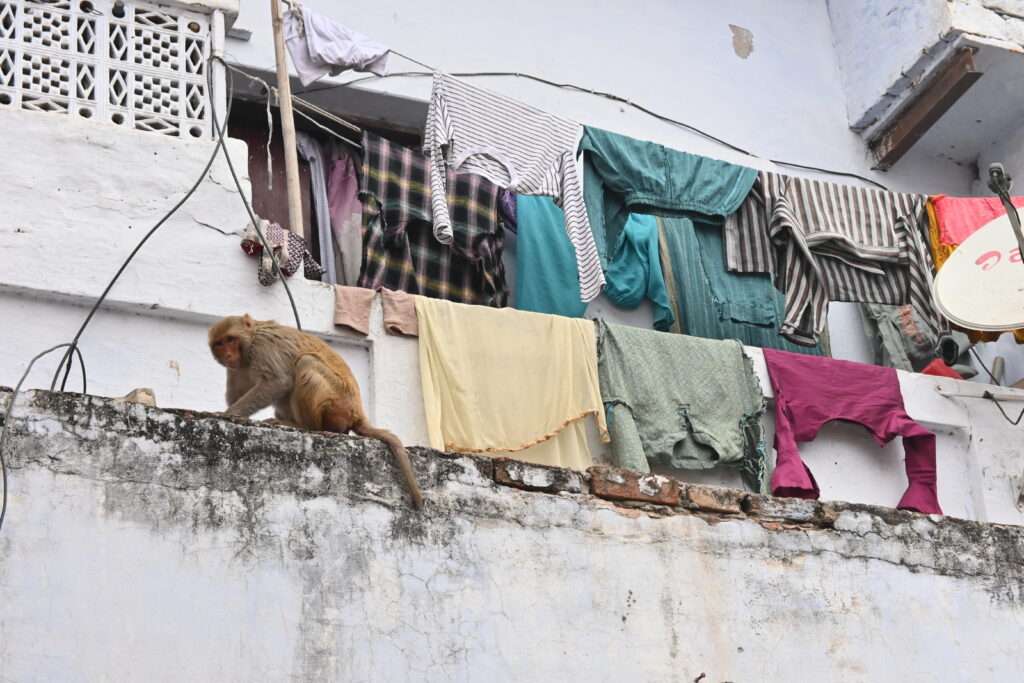







We stroll through the streets of Agra, which is far from the small romantic town we had hoped for.
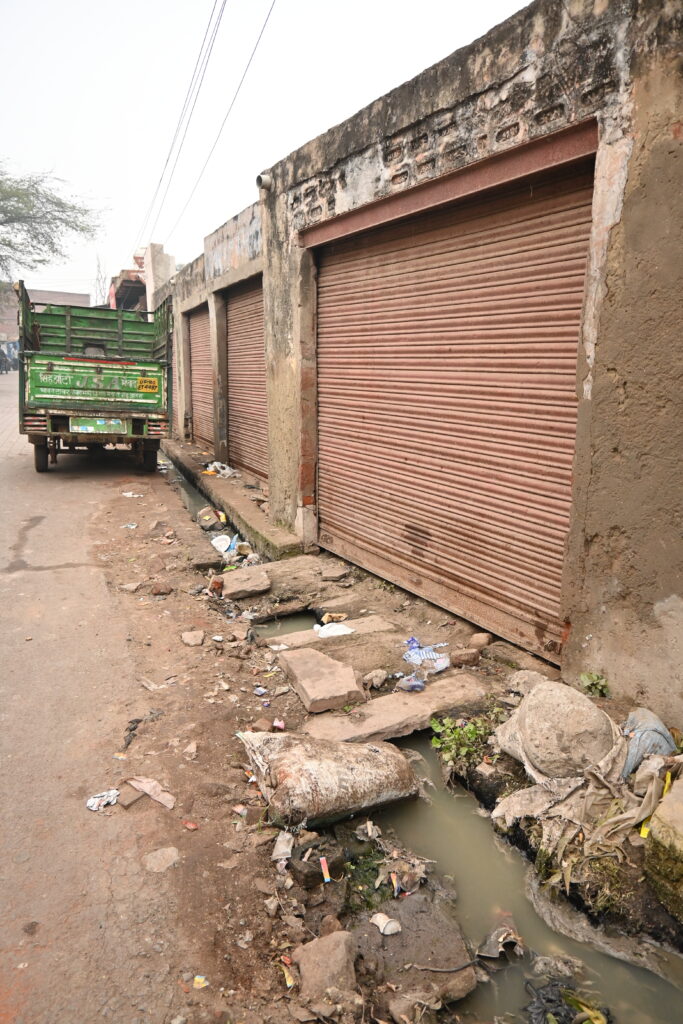

Day 3: The sky remains hazy, and we spend the morning at Agra Fort, the largest in India. The blend of red sandstone and white marble is truly beautiful.







Back at the hotel, we catch a monkey relishing the sliced bread stolen from another guest in the communal kitchen…

In the afternoon, we have incredible luck: the fog clears, revealing a blue sky. Without hesitation, we rush to the Taj Mahal and spend the rest of the day admiring this magnificent site. The Taj Mahal lives up to its reputation, and we are captivated by this wonder of the world.








Day 4: We take the 6 am train to Jaipur. Like Agra, Jaipur, the capital of Rajasthan, is a big, dirty, and noisy city. We navigate the streets, doing our best to avoid getting hit by a tuk-tuk or scooter, zigzagging through litter on the ground and holes in the sidewalks. The city, nicknamed the Paris of India or the Pink City (even though the buildings are more orange than pink), is not the most romantic place…




In the vicinity of the Hawa Mahal, a few buildings are well-preserved, but they are quite rare.


Certainly, the Hawa Mahal is magnificent.


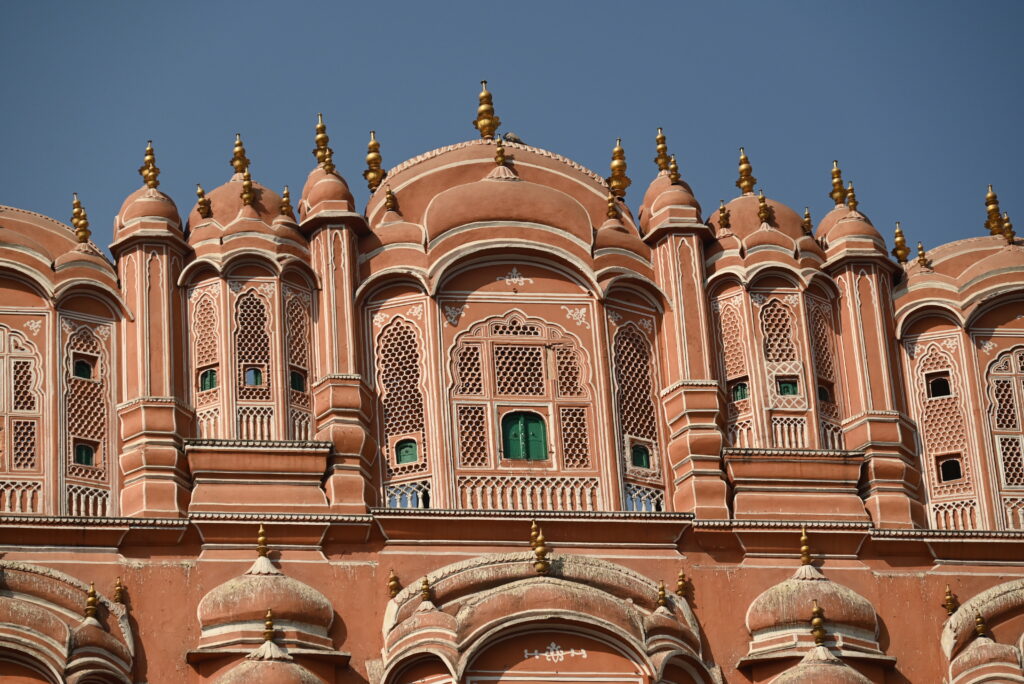
Day 5: The day is dedicated to exploring the Amber Fort, which overlooks the surroundings.

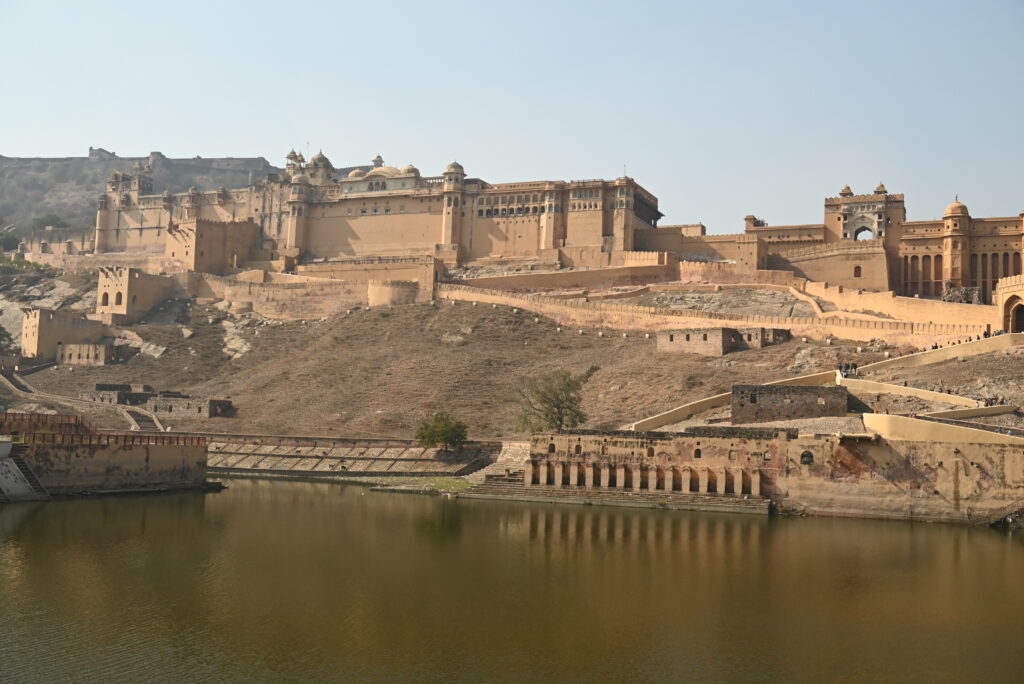

The fort is vast and must have been magnificent. Unfortunately, a clear lack of renovation makes it a bit dull and poorly preserved. Visitors also have a regrettable tendency to carve their names on the walls and paintings, mistreating the building. It’s not the first time we’ve witnessed this phenomenon in India, but it’s particularly striking here.





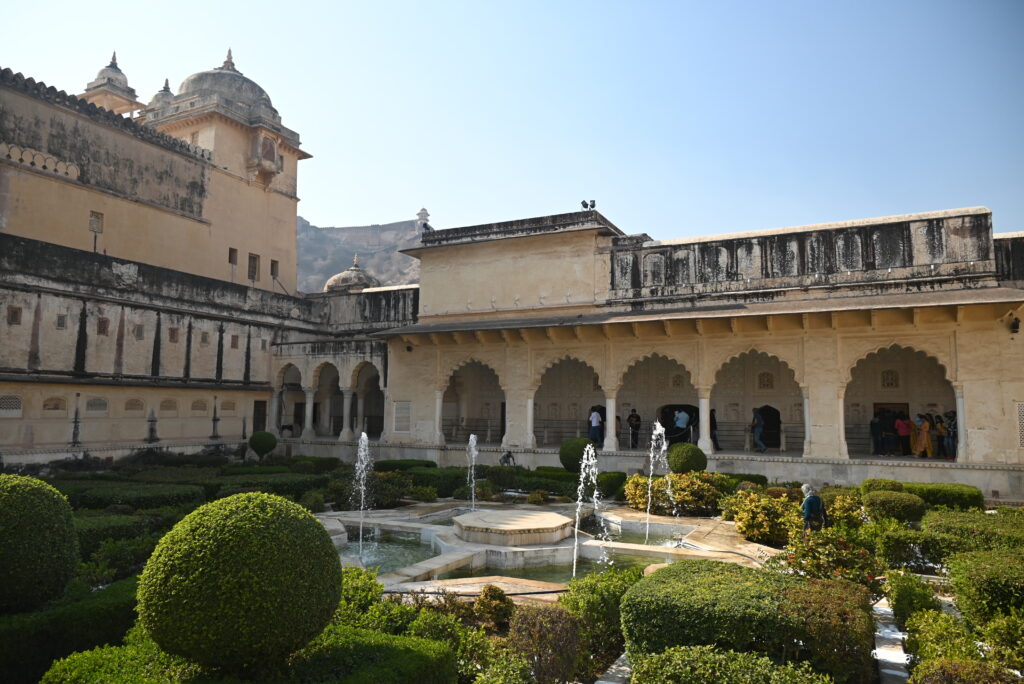
Exiting the fort, we walk for about fifteen minutes to admire the fascinating stepwell (bāoli) known as Panna Meena ka Kund.



Day 6: In the morning, we visit the City Palace, the royal residence of the former rulers of the state of Rajasthan. The entrance fee for foreigners is high, and the visit is relatively quick. The building itself lacks architectural interest, with rooms transformed into exhibition spaces. While we quickly pass through some (such as the armory), we linger a bit longer in those showcasing paintings and the transportation means of the maharajas. However, we are frustrated not to be allowed to take photos as it is prohibited in the exhibition rooms. We conclude the visit with a very brief stop at the shop: the prices are exorbitant.




We return to the hotel to work on the blog.

Day 7: We catch the first train of the day, heading to Udaipur, where we arrive 7 hours later. After checking in at the hotel, we venture out to explore the city. The observation is striking: the city is smaller, more intimate, and notably cleaner. The lake at the center of the town and the greenery everywhere make us realize we haven’t seen anything like this since our arrival in India.




We are fortunate to have stumbled upon a Hindu festival. The streets are overflowing with life. There is vibrancy, colors, and music everywhere.





François is even included in the celebration. A man gives him his scarf, and a child stamps his forehead. What a warm welcome!

We fall asleep (with difficulty) to the sound of fireworks exploding just beneath our window.
Day 8: We spend the morning at the City Palace, much more impressive (and less expensive!) than its counterpart in Jaipur. Built over 400 years, this one is a true complex housing several palaces. The visit takes two hours as we wander through the different spaces. Unlike Jaipur’s, some rooms are furnished, enhancing visitors’ immersion. However, the number of visitors is staggering. It’s not uncommon to queue to move from one room to another. The significant number of visitors (and the lack of courtesy of most of them) also makes taking photos quite challenging. Nevertheless, the visit is worthwhile.









In the afternoon, we visit the Shri Jagdish Hindu temple, which we had glimpsed the day before during the celebrations. It’s much quieter today, allowing us ample time to admire the numerous sculptures depicting humans, animals, and deities that adorn it.




Day 9: We explore the city’s shops in search of souvenirs and postcards. For once since our arrival in India, the shops are plentiful, easy to find, and the sellers are not (too) intrusive. And the prices are much lower!

We take advantage of the opportunity to also capture some photos of the painted murals adorning the walls throughout the city.




Day 10: We leave Udaipur for Jodhpur, this time by bus. Farewell to calm, serenity, and cleanliness… We’re back to the cacophony of honks and the hustle and bustle of Indian streets. The next day is Republic Day, and the residents are gearing up for the celebration. The streets are adorned in the colors of the Indian flag.


Day 11: We stroll through the streets of Jodhpur and start the day at the Toorji Ka Jhalra stepwell.





The rest of the day is dedicated to exploring Mehrangarh Fort, which overlooks the city.


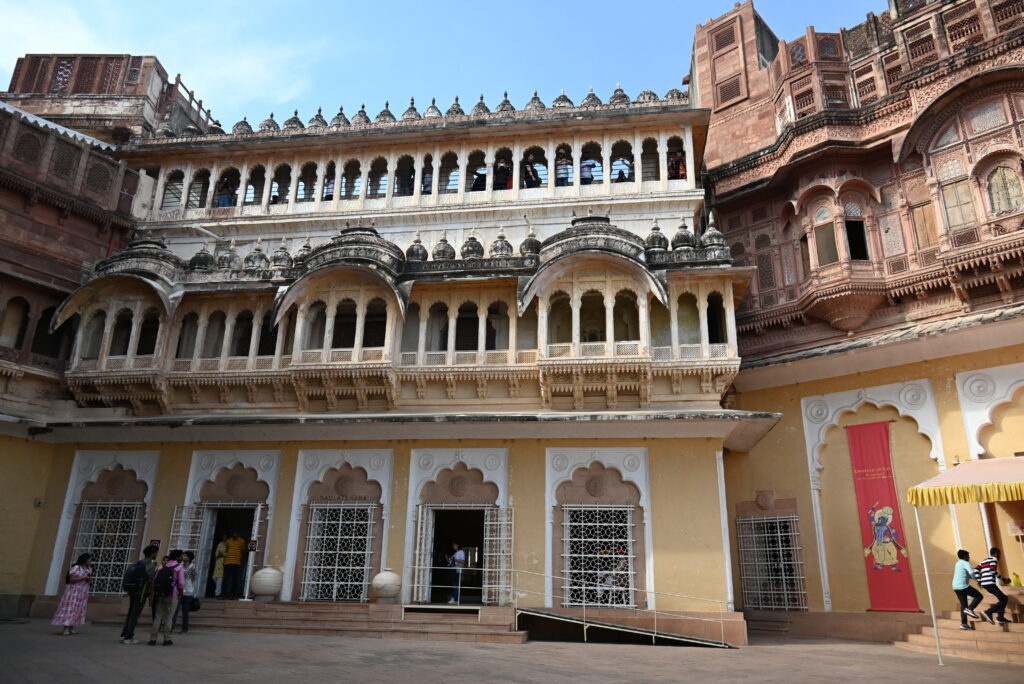


Day 12: In the morning, we wander through the lively center of Jodhpur, away from the touristy part of the city (though not necessarily a more tranquil neighborhood!).



The afternoon is dedicated to visiting Jaswant Thada, the “Taj Mahal of Mewar.” The site may not be as magical and grandiose as the Taj Mahal, but it’s worth a visit.






Day 13: We take the bus to Jaisalmer (5 hours). Unlike other cities on our itinerary, Jaisalmer is a small town (only 65,000 inhabitants), situated in a desert landscape (Thar Desert). However, once again, one should not expect a calm and restful city. The old center is within the fort, still inhabited, and where our hotel is located. The city extends around the fort and boasts beautiful mansions (havelis).

We have a beautiful view of the fort from our hotel room.

Day 14: We stroll through the streets of the fort, filled with souvenir shops. The buildings are very beautiful, although not all are well-preserved. The fort is not very large, and one can circle it in about an hour (if lingering in a few shops).






We exit the fort and take a walk through the town, where cows roam at every street corner. We visit the stunning Kothari’s Patwon Ki Haveli.


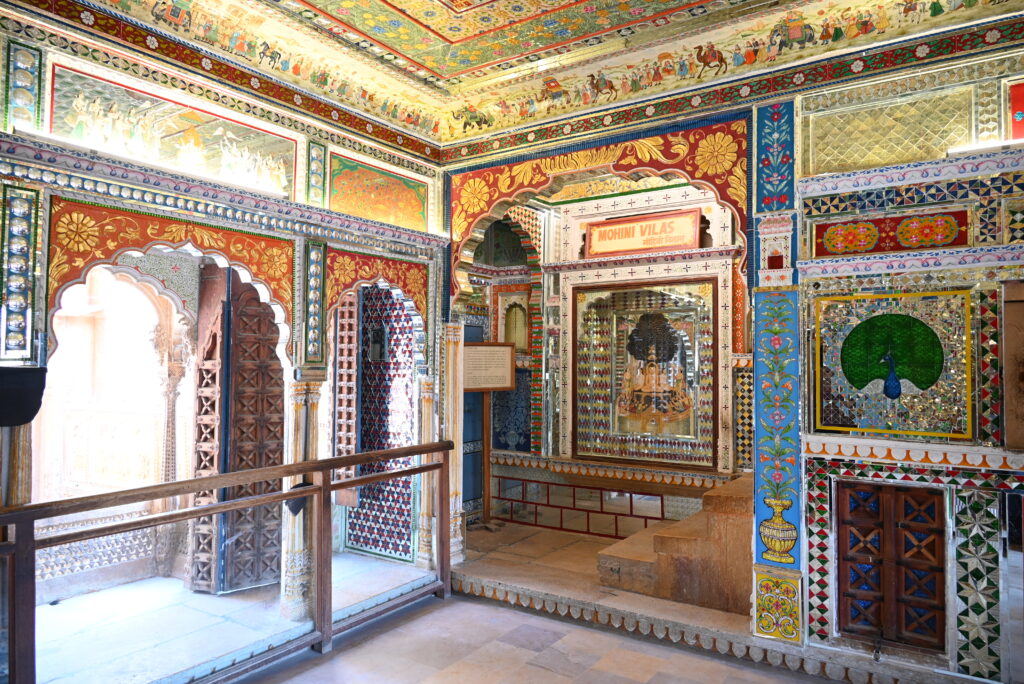

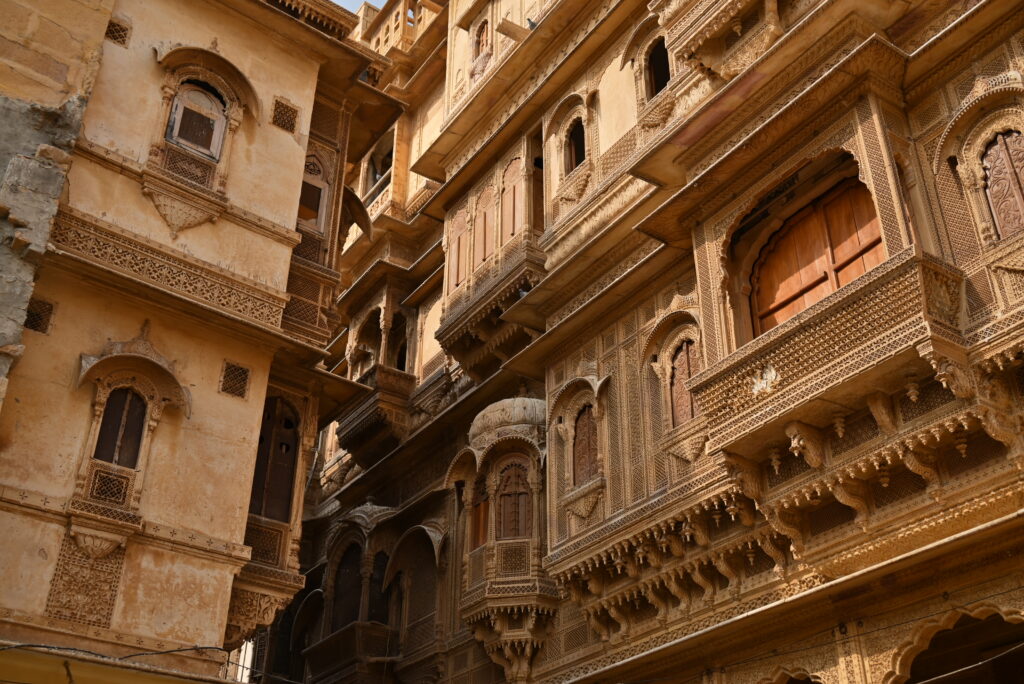


Day 15: We visit the Jain temples of Jaisalmer, located within the fort. They showcase beautiful sculptures. As we go early, before the arrival of groups, we have the place almost to ourselves.








The rest of the day is dedicated to some rest (and blogging): we still have 7 months of travel ahead of us!

Day 16: It’s time to return to our starting point: we take a flight back to Delhi. Since our flight is early two days later, we opt for a hotel near the airport. It turns out to be a good choice: the neighborhood (Mahipalpur) is quieter than Paharganj, where our first hotel was located.


Day 17: Last day in India. This time, we stay in New Delhi to visit three sites. We begin with Humayun’s Tomb, a site reminiscent of the Taj Mahal. When we arrive, there is no one around, creating a truly pleasant atmosphere despite the pollution haze covering Delhi’s sky.


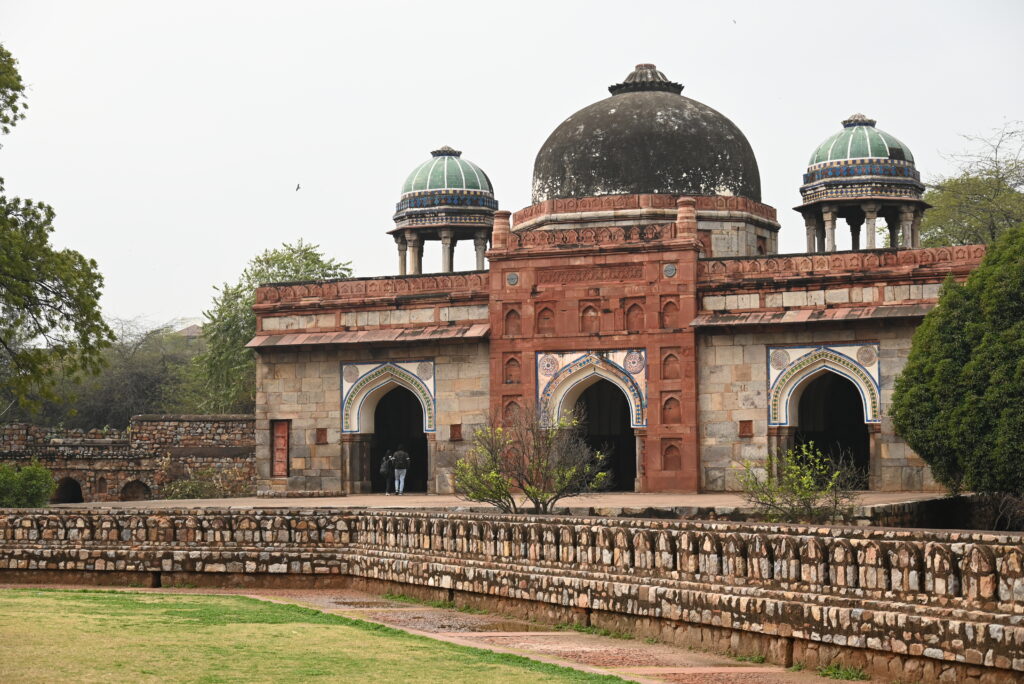


We then visit the Lotus Temple, whose exterior architecture resembles the Sydney Opera House, but the interior holds no particular interest.


After about a fifteen-minute walk, we then reach the ISKCON Temple, which attracts fewer tourists but that we enjoyed a lot. The religious fervor and the warm welcome from the devotees made our visit quite pleasant.





Day 18: We leave Delhi at 8:30 in the morning, despite thick fog! We continue our world tour towards Bangkok: a guaranteed change of climate and atmosphere!


Find all our other articles on India:




